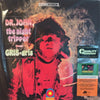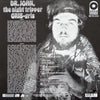





Dr. John - Gris-Gris (2LP, 45 RPM)
Dr. John - vocal, keyboards, percussions [click here to see more vinyl featuring Dr. John]
Harold Battiste (b, cl, perc, arr); Plas Johnson (sax); Lonnie Boulden (fl); Steve Mann (g, bjo); Richard Washington (perc); Bob West (b); John Boudreaux (dr); Mo "Dido" Pedido (cga)
Written by Dr. John Creaux (A1, A2, B1, B2, C2, D1), Harold Battiste (A2, C1), Jessie Hill (B1)
2 LP, gatefold double pocket jacket
Limited numbered Edition
Original analog Master tape : YES
Heavy Press : 180g
Record color : black
Speed : 45 RPM
Size : 12'’
Stereo
Studio
Record Press : QRP
Label : Analogue Productions - Atlantic 75 Series
Original Label : Atlantic
Recording: 1967 at Gold Star Studios, Los Angeles
Produced by Harold Battiste
Originally released in 1968
Reissued in 2024
Tracks :
Side A:
- Gris-Gris Gumbo Ya Ya
- Danse Kalinda Ba Doom
Side B:
- Mama Roux
- Danse Fambeaux
Side C:
- Croker Courtbullion
- Jump Sturdy
Side D:
- I Walk On Guilded Splinters
Awards:
Rolling Stone 500 Greatest Albums of all Time - Ranked No. 143
1000 Recordings you must hear before you die - Ranked 122
Reviews :
« Dr. John's Gris-Gris is among the most enduring recordings of the psychedelic era; it sounds as mysterious and spooky in the 21st century as it did in 1968. It is the album where Mac Rebennack established a stage identity that has served him well. A respected studio ace in his native New Orleans, Rebennack was scuffling in L.A. Gris-Gris was his concept, an album that wove various threads of New Orleans music together behind the character of "Dr. John," a real voodoo root doctor from the 19th century. Harold Batiste, another ex-pat New Orleanian and respected arranger in Hollywood, scored him some free studio time left over from a Sonny & Cher session. They assembled a crack band of NOLA exiles and session players including saxophonist Plas Johnson, singers Jessie Hill and Shirley Goodman, and guitarist/mandolinist Richard "Didimus" Washington. Almost everyone played percussion. Gris-Gris sounds like a post-midnight ceremony recorded in the bayou swamp instead of L.A.'s Gold Star Studio where Phil Spector cut hits. The atmosphere is thick, smoky, serpentine, foreboding. Rebennack inhabits his character fully, delivering Creole French and slang English effortlessly in the grain of his half-spoken, half-sung voice. He is high priest and trickster, capable of blessing, cursing, and conning. On the opening incantation "Gris-Gris Gumbo Ya Ya," Dr. John introduces himself as the "night tripper" and boasts of his medicinal abilities accompanied by wafting reverbed mandolins, hand drums, a bubbling bassline, blues harmonica, skeletal electric guitar, and a swaying backing chorus that blurs the line between gospel and soul. On "Danse Kalinda Boom," a calliope-sounding organ, Middle Eastern flute, Spanish-tinged guitars, bells, claves, congas, and drums fuel a wordless chorus in four-part chant harmony as a drum orgy evokes ceremonial rites. The sound of NOLA R&B comes to the fore in the killer soul groove of the breezy "Mama Roux." "Croker Courtboullion" is an exercise in vanguard jazz. Spectral voices, electric guitars, animal cries, flute, and moody saxophone solos and percussion drift in and out of the spacy mix. The set's masterpiece is saved for last, the nearly nearly eight-minute trance vamp in "I Walk on Gilded Splinters" (covered by everyone from Humble Pie, Cher, and Johnny Jenkins to Paul Weller and Papa Mali). Dr. John is brazen about the power of his spells in a slippery, evil-sounding boast. Congas, tom-toms, snaky guitar, and harmonica underscore his juju, while a backing chorus affirms his power like mambo priestesses in unison. A ghostly baritone saxophone wafts through the turnarounds. Droning blues, steamy funk, and loopy R&B are inseparably entwined in its groove. Remarkably, though rightfully considered a psychedelic masterpiece, there is little rock music on Gris-Gris. Its real achievement -- besides being a classic collection of startlingly deep tunes -- is that it brought New Orleans' cultural iconographies and musical traits to the attention of an emergent rock audience. » AllMusic Review by Thom Jurek
His grandmother is purported to have transported objects using her spiritual powers and it is said that she sometimes floated through the room. Her grandson Malcolm Rebenneck was fully aware of his unique features when he appeared under the name of Dr. John, a voodoo healer in the 19th century, and was the first person to transcend from pitch-black spheres to psychedelic music as its high priest, so to speak.
In the seven magical musical numbers of "Gris-gris", the root doctor conjures up a potent mixture of creole melodies, primeval heathen sounds, a pinch of mardi-gras and New Orleans jazz and even undreamt-of sounds. "Gumbo Ya Ya", a dragging procession with archaic sing-song, shows that suggestive Afro sounds are what rule in this album. And to play with them, to soften them here and there, or to enhance them with dance-like expression and voices from afar ("Danse Fambeaux") is all part of the programme in this collection of artistic treasures. In between raspy sounds there are flattering, intimate tones such as the springy, gentle and forward-looking "Croker Courtbullion".
The equation Witchcraft = Masterwork certainly applies to this unrivalled album, which is listed at No. 143 in the 500 Greatest Albums of all Time by the magazine Rolling Stone.
The debut album from the king of the psychedelic bayou — the hypnotic, mystical and powerful sound of the swamp coming to life. As he became Dr. John (real name Mac Rebennack), it was his L.A. session work with musicians such as Sonny & Cher, Canned Heat, and Zappa that allowed him to start conjuring up his visions of guitar psych-pop to walk alongside his authentic New Orleans upbringing.
Gris-Gris was released on Atco Records, a sub label of Atlantic, in 1968. The musical style of Gris-Gris is a hybrid of New Orleans rhythm and blues and psychedelic rock. The album introduced Rebennack's Dr. John character, inspired by a reputed 19th century voodoo doctor.
The album was taken under the wing of a small percentage of the "underground" upon its release in 1968 and did not find a true following for years.
Allmusic gave the album five out of five stars, referring to it as "The most exploratory and psychedelic outing of Dr. John's career" and "that it "sounds like a post-midnight ceremony recorded in the bayou swamp," naming it "among the most enduring recordings of the psychedelic era; it sounds as mysterious and spooky in the 21st century as it did in 1968."
Ratings :
AllMusic : 5 / 5 , Discogs :




